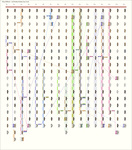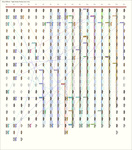| Statistics: |
Original Author: Marcia & Robert Ascher
Museum: Private Collection: Anna Maria Soldi, Lima, Peru
Museum Number: 1
Provenance: Unknown
Region: Unknown
|
# of Cords: 370 (313p 57s)
# of Unique Cord Colors: 15
Benford Match: 0.3358
# Ascher Sums (pps, ips, cps, sps,...): 77 (59, 5, 9, 4,...)
Similar Khipu: Previous (UR1176) Next (AS128)>
|
|
| Notes: |
Ascher Databook Notes:
- By spacing and color patterning, the khipu is separated into 3 parts : part 1 is 3 groups, and parts 2 and 3 are 7 groups each.
- Part 1: Assuming that position 10 in group 1 is non-existent, this part consists of 3 groups of 20 pendants each. The color pattern is the same for all 3 groups (with the exception of position 17 in group 3). In all 3 groups, subsidiaries appear only in positions 3, 8,9, 11, 14, 15, 16, 18, 19, 20.
- Parts 2 and 3:
- Each part is basically 7 groups of 18 pendants. The exceptions of 2 groups with 19 pendants are systematic. The 6th group in each part has an additional W pendant between positions 7 and 8.
- Each group in parts 2 and 3 has the same color pattern (with the exception of position 8 in groups 4 and 5 and position 18 in group 4). The color pattern is the same as in part 1 with the systematic difference that positions 5 and 8 of the part 1 pattern do not exist. Thus, there are 18 pendants in each group in parts 2 and 3 as compared to 20 pendants in each group in part 1. Also, while the color in position 19 of the groups in part 1 are B, in parts 2 and 3, the comparable position is BD.
- Subsidiaries on pendants in parts 2 and 3 are on a subset of the positions they are on in part 1. Namely, subsidiaries are only on positions comparable to positions 9,15,16,18,20 of part 1.
- Many values are uncertain due to breakage. However, we hypothesize that, position by position, values in group 1 of part 1 are related to the sums of values in groups 2 and 3 while values in groups 2 and 3 are related to sums of values in parts 2 and 3 respectively.
|















